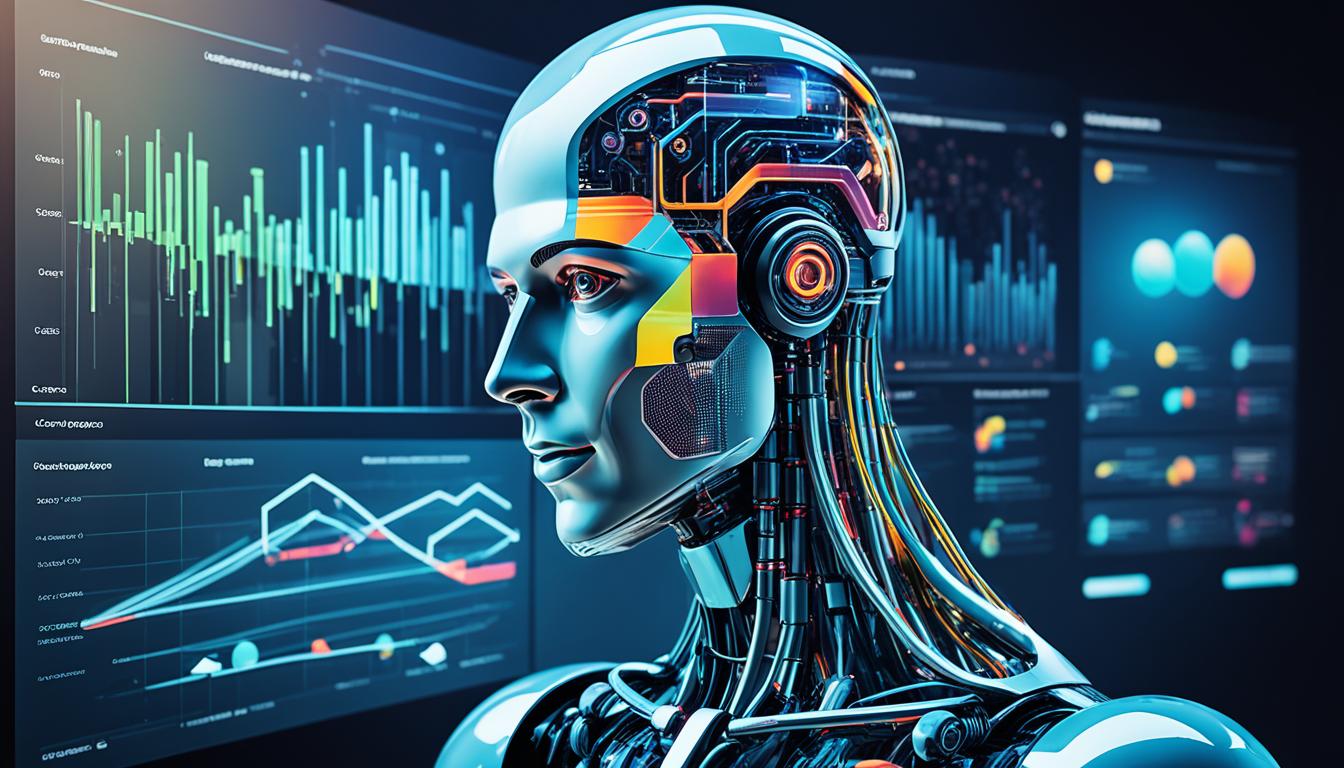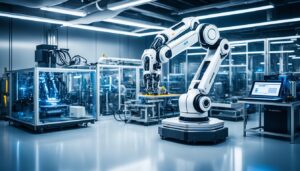
Artificial intelligence (AI) is changing data analytics greatly. It brings new tools and ways of working. These changes affect data analysts and their work deeply.
Machine learning and natural language processing are part of AI. They help analyze big and complex data quickly. Tools powered by AI, like predictive analytics, are making business insights better by predicting future trends and understanding customer feelings.
There’s also generative AI, a new tool for data analysts. It can do many things, such as understanding code, solving problems, and making data analysis easier. It even helps with making presentations, creating fake data, and improving predictions.
Key Takeaways:
- The increasing prominence of AI is reshaping data interpretation.
- AI-powered tools such as predictive analytics and text analytics are revolutionizing business insights.
- Generative AI offers powerful capabilities for data analysts.
- AI enables the analysis of large volumes of complex data at high speeds.
- The future of data analysis revolves around embracing AI-driven techniques.
The Evolution of AI and its Impact on Data Analysis
AI has changed data analysis from the ground up. Before, this field mainly used manual efforts and simple stats. Now, AI and machine learning have made data analysis far more advanced and efficient.
AI can work through big, complicated data sets. It finds patterns and insights that humans might not see. This means data analysis is not only quicker but also more precise. Using machine learning, we can now delve into complex data unlike ever before.
Important tools in AI data analysis are machine learning, deep learning, and data mining. Machine learning helps computers make predictions from data, without direct instructions. Deep learning copies the brain’s ways to sift through huge amounts of data. Data mining finds patterns and connections in large data sets.
AI is changing how we understand data, offering new possibilities for many industries.
AI makes data analysis faster by handling big, complex data sets. It helps organizations find useful insights, make smarter choices, and boost their success.
Advantages of AI-driven Data Analysis
- More accurate: AI spots trends and insights that might escape humans, leading to better data understanding.
- Speedier data work: AI looks at large, complex data sets quickly, making data analysis more efficient.
- Automation: AI automates routine tasks, freeing analysts to focus on deeper analysis.
- Better decisions: AI offers deep insights and forecasts, helping organizations choose wisely.
- Scalability: AI manages big, varied data sets easily, simplifying expansion of data analysis projects.
The Future of AI in Data Analysis
The future of AI in data work looks bright. We’re always finding better AI tech. Quantum computing and better neural networks will make AI even stronger.

Quantum computing will let us handle huge data sets in real-time. This means faster, more detailed analysis. Neural networks, like our brains, will make AI smarter and more capable.
As companies rely more on data, AI will be key in finding success. AI helps organizations stand out, uncover insights, and make the best decisions for growth and innovation.
Enhancing Predictive Analytics with AI
AI has changed predictive analytics drastically. Machine learning and deep learning let us handle lots of data. They find patterns and predict future trends. This is useful in many areas like market trends, customer behavior, risk management, and healthcare.
With AI, predictions become more accurate. This helps in making smart decisions. By learning from past data, AI can forecast what’s next. This lets organizations use their data better, making models to predict the future.
AI-driven Predictive Analytics in Action
In healthcare, AI is making a big difference. For example, Hospital X uses AI to predict if patients will need to come back within 30 days after leaving. They look at medical records and lab results to make their predictions.
The AI uses machine learning to spot patterns in patient data. It considers things like age and medical history. Then, it predicts who might need to come back. Doctors can use this info to prevent readmissions with better care and planning.
Such AI systems not only help patients but also save money for hospitals. By cutting down readmissions, Hospital X spends less and works more efficiently. This is good news for everyone involved.

“AI-driven predictive analytics provides more accurate forecasts and enables more informed decision-making.”
But healthcare isn’t the only field benefiting from AI. Retailers use it to predict buying trends and tailor marketing. In finance, it helps catch fraud by checking tons of transactions quickly.
AI in predictive analytics is shaping our future. It’s getting better and helping us make smarter choices. As AI grows, we’ll see even more advanced ways to predict and plan.
Conclusion
AI has changed data analytics in big ways. It makes data analysis more accurate and efficient. Now, we can spot hidden trends and patterns better.
This has improved decision-making a lot. The future of AI in this field is looking up, thanks to new tech like quantum computing and neural networks. These will boost AI’s data handling, making analysis quicker and insights sharper.
For organizations and data analysts, keeping up with AI is key. AI doesn’t aim to take over human jobs. Instead, it’s here to make data analysis easier and more powerful. It offers great tools for understanding data and making smart choices.
FAQ
What is AI analysis in data interpretation?
How does AI-driven data analysis differ from traditional data analysis methods?
How does AI enhance predictive analytics?
How does data mining contribute to AI-driven data analysis?
Why should organizations embrace AI-driven data analysis?
Source Links
- https://www.iiba.org/business-analysis-blogs/how-ai-is-rewriting-the-rules-of-data-analysis/
- https://jenni.ai/artificial-intelligence/data-analysis-usage
- https://www.linkedin.com/pulse/ai-driven-data-analysis-uncovering-hidden-insights-ashutosh-shashi-0uvve






